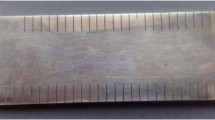Abstract
In the present study an analysis has been done to evaluate the electrode wear along the cross-section of an electrode compared to the same along its length during EDM of aluminum and mild steel using copper and brass electrodes. In an overall performance comparison of copper and brass electrodes, we found that electrode wear increases with an increase in both current and voltage, but wear along the cross-section of the electrode is more compared to the same along its length. This is due to easier heat transfer along the length compared to the same along the cross-section of the electrode. It was also found that the wear ratio increases with an increase in current. That means, though a higher current causes more removal of work material and the electrode, comparatively more material is removed from the electrode. The highest wear ratio was found during machining of steel using a brass electrode. The low thermal conductivity of brass electrodes causes less heat loss, and its low melting point results in fast melting of the electrode material. At the same time, low thermal conductivity of steel results in poor heat absorption, and its high melting temperature causes poor removal of work material. These factors result in the highest wear ratio during machining of steel using a brass electrode. The highest material removal rate was observed during machining of aluminum using brass electrodes. Comparatively low thermal conductivity of brass as an electrode material does not allow the absorption of much heat energy, and most of the heat is utilized in the removal of material from aluminum workpiece at a low melting point. But during machining of steel using copper electrodes, a comparatively smaller quantity of heat is absorbed by the work material due to its low thermal conductivity. As a result material removal rate becomes very low.
Similar content being viewed by others
References
Zarepour H, Tehrani AF, Karimi D, Amini S (2007) Statistical analysis on electrode wear in EDM of tool steel DIN 1.2714 used in forging dies. J Mater Process Technol 187–188:711–714
Wang PJ, Tsai KM (2001) Semi-empirical model on work removal and tool wear in electrical discharge machining. J Mater Process Technol 114(4):1–17
Ghosh A, Mallik AK (1991) Manufacturing Science. Affiliated East-West Press, New Delhi
Yan BH, Tsai HC, Huang FY (2005) The effect of EDM of a dielectric of a urea solution in water on modifying the surface of titanium. Int J Mach Manuf 45(2):194–200
Ho KH, Newman ST (2003) State of art electrical discharge machining (EDM). Int J Mach Manuf 43(13):1287–1300
Khan AA, Mridha S (2006) Performance of copper and aluminum electrode during EDM of stainless steel and carbide. Int J Manuf Sc & Prod 7(1):1–7
Marafona J, Wykes C (2000) A new method of optimizing material removal rate using EDM with copper-tungsten electrodes. Int J Mach & Manuf 40:153–164
Wang PJ, Tsai KM (2001) Semi-emperical model of surface finish on electrical discharge machining. Int J Mach Manuf 41:1455–1477
Kalpakjian S, Schmid SR (2001) Manufacturing engineering and technology, 4th edn. Prentice Hall, Upper Saddle River
Zaw HM, Fuh JYH, Nee AYC, Lu L (1999) Fabrication of a new EDM electrode material using sintering techniques. J Mater Process Technol 89–90:182–186
Khanra AK, Sarker BR, Bhattacharya B, Pathak LC, Godkhindi MM (2007) Performance of ZrB2-Cu composite as an EDM electrode. J Mater Process Technol 1831:122–126
Ramasawmy H, Blunt L (2001) 3D surface characterization of electropolished EDMed surface and quantitative assessment of process variables using Taguchi Methodology. Inter J Mach Manuf 42:1129–1133
Hu CF, Zhou YC, Bao YW (article in press) Material removal and surface damage in EDM of Ti3SiC2 ceramic. Ceramics Int
Bleys P, Kruth JP, Lauwers B (2004) Sensing and compensation of tool wear in milling EDM. J Mater Process Technol 149(1–3):139–146
Puertas I, Luis CJ, Alvarez L (2004) Analysis of the influence of EDM parameters on surface quality, MRR and EW of WC-Co. J Mater Process Technol 153–154(10):1026–1032
Kunieda M, Kobayashi T (2004) Clarifying mechanism of determining tool electrode wear ratio in EDM using spectroscopic measurement of vapor density. J Mater Process Technol 149(1–3):284–288
Kunieda M, Muto H (2000) Development of multi-spark EDM. Ann CIRP 49(1):119–122
Salah BS, Ghanem F, Atig KB (2006) Numerical study of thermal aspects of electric discharge machining process. Int J Mach Manuf 46(7–8):908–911
Author information
Authors and Affiliations
Corresponding author
Rights and permissions
About this article
Cite this article
Khan, A.A. Electrode wear and material removal rate during EDM of aluminum and mild steel using copper and brass electrodes. Int J Adv Manuf Technol 39, 482–487 (2008). https://doi.org/10.1007/s00170-007-1241-3
Received:
Revised:
Accepted:
Published:
Issue Date:
DOI: https://doi.org/10.1007/s00170-007-1241-3



